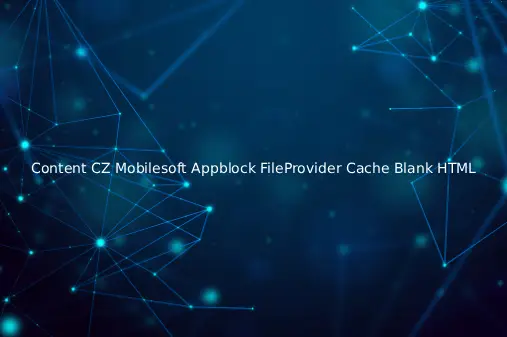The rapidly developing market of mobile app development, making sure that users have seamless experience, optimizing performance and ensuring security are essential for the successful development of a mobile app. Different concepts and tools aid the developers reach their goals such as Content CZ, Mobilesoft, Appblock, FileProvider, cache management, as well as tackling problems like empty HTML. Each component plays crucial roles in enhancing the app’s functionality, speed as well as security. This article delved into these subjects deep, revealing the significance of these components and how developers can make use of these components to build powerful Android apps.
1. Understanding Content CZ: The Backbone of Modern Apps
Content CZ is a crucial aspect of mobile app development. It is the term used to describe the arrangement and administration of data inside the app. This usually happens via Content service providers. Content CZ offers a standardized method for developers to control and securely share information throughout the various parts of an application or between different apps.
In the case of Android development In the Android development process, Content CZ is usually implemented through Content Providers. This is a system that lets apps securely transfer data to other applications. As an example, an application could require access to media or contacts stored in the mobile device. Through the use of Content Providers developers can ensure that transactions are done in a secure manner without jeopardizing privacy of the user.
Content CZ also helps developers handle large data sets, as well as sensitive data and provides that data is consistent across the various components of the app. This is especially important when dealing with data from users since apps must offer reliable practices for managing data to provide a pleasant user experience.
2. Introduction to Mobilesoft: Developers’ Guide to Efficient Mobile Solutions
Mobilesoft is a platform for development which aims to simplify development of mobile applications, and focuses on offering developers tools that allow them to develop faster and efficient. No matter if you’re creating applications to run on Android and iOS, Mobilesoft offers a set of frameworks and tools that can boost efficiency.
Mobilesoft’s products include frameworks that allow for simple integration with APIs, tools to create a seamless UI/UX as well as sophisticated analytics to monitor the performance of apps. The company also offers templates, modules that are pre-built, and support for debugging which allows developers to cut down on the amount of time they spend doing repetitive work and instead focus more on the artistic elements of developing apps.
In addition, the Mobilesoft’s focus on privacy and security means that developers build safe mobile applications without risking personal information of the users. Mobilesoft is especially beneficial for those who want to cut down on the development process and ensure their applications are top-quality and secure.
3. Appblock: Ensuring User Control and Privacy
Today the users want more control of their gadgets and applications. Appblock, which prevents or limits access to specific apps and functions, is used as an essential tool in increasing privacy for users and efficiency. Appblock is typically employed to limit the distractions they experience or limit access to particular apps for a specified time.
In particular, Appblock can be employed in mobile apps created to decrease screen time. This will ensure that users do not spend time using apps that don’t produce any results. For developers the integration of Appblock in apps can provide users with a greater control over their online experience, which leads to a higher retention rate and overall satisfaction.
Security-wise, Appblock can also limit access to specific parts of an application to guard private information, making sure that apps or users who are not authorized are not able to interfere with or abuse the app. This means that Appblock an indispensable tool in protecting the privacy and integrity of the app as well as its users.
4. FileProvider: Simplifying File Sharing and Access
The sharing of files between applications is an essential function of the development of mobile apps. FileProvider is a feature in Android. FileProvider is an option in Android which lets apps connect files with security to other applications. Instead of directly connecting to the files in the File device, FileProvider creates a secure abstracted URI (Uniform Resource Identifier) which other applications may use to open file files.
Utilizing this API FileProvider API, developers can keep their sensitive data from being exposed by directly exposing data, and ensure that the files can be shared securely way. This is crucial when dealing with files, images and videos or other file that the user needs to share with other applications for their device.
One of the major benefits of FileProvider is its capability to protect against security threats like unauthorized access and modifications to the files. When properly using FileProvider developers are able to ensure that the user’s data is secure, yet allowing easy file sharing among multiple applications.
5. The Role of Cache in Mobile App Performance
Cache is a key element in enhancing mobile applications’ performance. Caching is the practice of temporarily storing data at a place that can be quickly access, which reduces the requirement for repeat request for data from servers. With the help of caching mobile applications are able to be faster to load, react quicker and offer a more pleasant overall experience for users.
There are various types of caching mechanism used by mobile applications, such as memory cache (RAM) as well as disk cache (storing information within the storage of the device). Memory cache permits users to quickly access frequently-used data. Disk cache is used to keep data in between sessions, which reduces the requirement for loading from servers each time an application is used.
If used properly when used correctly, caches can dramatically improve application performance, by decreasing loading times and latency. But, improper management of caches may result in problems including stale or excessive usage of storage. The developers must be careful about managing sizes of caches, expiration dates as well as data invalidation procedures so that the application can continue functioning properly without taking up inefficient resources.
6. Blank HTML in Mobile Applications: A Common Challenge
Blank HTML is an issue that’s commonly that developers face in working with web-based views or dynamic content within mobile apps. The issue arises in the event that an application fails to display or load content correctly, which results in empty or blank pages displayed to users. This can be due to a number of causes such as inadvertent integration of resources technical issues with the network, or a mistake within the application’s code.
The reason for empty HTML may range from problems with the server, such as failing API calls or missing data or front-end problems like JavaScript issues or incorrect HTML tags. Finding the cause behind the issue requires looking for damaged hyperlinks, missing resources or incorrect configurations.
Developers must deal with issues with blank HTML issues early, by employing appropriate fallback methods and handling of errors. In the event that the app is confronted with a blank webpage and it displays the loading indicator or error message that informs users of the problem, while ensuring that the app stays user-friendly, even in situation of a glitch.
7. How These Concepts Interrelate in Mobile App Development
The ideas are Content CZ, Mobilesoft, Appblock, FileProvider, cache management and blank HTML are all interconnected with modern mobile app development. With the use of Content CZ to manage app data effectively, developers can assure a seamless circulation of data within the application. Mobilesoft as a developer platform, facilitates the use of these functions by offering the tools and frameworks needed to allow developers to implement these features.
Appblock increases control of users and privacy. This ensures distracting factors are reduced and confidential data is secured. FileProvider allows secure sharing of files and ensures that apps are able to transfer data with no compromise to security. Cache management helps apps perform smoothly through slowing down load times, and also preventing the performance of apps from being hampered by bottlenecks. In addition, dealing with issues like the absence of HTML guarantees that users enjoy a smooth experience even in the event of unanticipated mistakes.
8. Best Practices and Tips for Developers
To developers, ensuring these ideas work together is essential to build robust and secure mobile apps. Below are some of the most effective techniques:
-
efficient data management: Utilize Content CZ efficiently to efficiently manage and organize information. Use Content Providers in a way that is secure so that data can be stored safely.
-
Make use of Mobilesoft Toolboxes: Take advantage of the tools and frameworks offered by Mobilesoft to speed up development and improve the quality of your app.
-
Use Appblock with care: Use Appblock to increase control of the use of apps and protect the privacy of users. Take note of the user experience while implementing features like this.
-
Utilize FileProvider Safely: Follow best practices to implement FileProvider to ensure that files are shared securely and not exposing sensitive data.
-
Improve Cache Management Apply caching techniques that improve app performance while also preventing concerns like excessive storage usage.
-
fix HTML0 issues that are blank: Address blank HTML issues by looking for code issues and network related problems and ensuring proper error-handling processes are present.
9. Conclusion
A successful mobile app development process requires an extensive understanding of instruments, theories as well as best practices to guarantee optimal efficiency, security, and users’ experience. Content CZ Mobilesoft, Appblock, FileProvider as well as cache management and the blank HTML issue are all essential to the process. With the help of these components and applying good practices, developers can develop apps which meet the expectations of users and run smoothly across various types of devices and networks.
While mobile technology develops These practices and devices are essential to ensure the apps offer fluid, secure as well as secure experiences for users. If you stay up-to-date on the most recent developments and technology, developers are able to develop innovative apps which push the limits of mobile technology.
Also Read: What Are the Basic Coding Concepts Every Beginner Should Know?
For more engaging content and the latest updates, follow The Bunk knot for insightful articles and fresh perspectives!
Also follow: mastodon.social/@bunkknot


